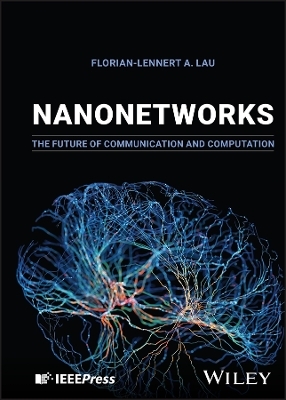
Nanonetworks
Wiley-IEEE Press (Verlag)
978-1-394-21310-8 (ISBN)
The field of nanoscale computation and communications systems is a thriving and interdisciplinary research area which has made enormous strides in recent years. A working knowledge of nanonetworks, their conceptual foundations, and their applications is an essential tool for the next generation of scientists and network engineers. Nanonetworks: The Future of Communication and Computation offers a thorough, accessible overview of this subject rooted in extensive research and teaching experience. Offering a concise and intelligible introduction to the key paradigms of nanoscale computation and communications, it promises to become a cornerstone of education in these fast-growing areas.
Readers will also find:
Detailed treatment of topics including network paradigms, machine learning, safety and security
Coverage of the history, applications, and important theories of nanonetworks research
Examples and use-cases for all formulas and equations
Nanonetworks is ideal for advanced undergraduate and graduate students in engineering and science, as well as practicing professionals looking for an introductory book to help them understand the foundations of nanonetwork systems.
Florian-Lennert A. Lau, PhD, MSc, obtained his MSc in 2016 and his PhD in 2020 from the Universität zu Lübeck, winning the KuVS award for the best Ph.D. thesis. He has been Head of the Nano Group since November 2021. His research interests cover self-assembly systems, nanonetworks, algorithmics, computational complexity theory, modelling human learning, human consciousness & logical inference systems, and distributed AI-systems.
List of Figures xiii
List of Tables xvii
About the Author xix
Preface xxi
Acknowledgments xxiii
1 Introduction 1
1.1 Etymology 1
1.2 Science Fiction 2
1.3 Nanotechnology Intuition 3
1.4 Example Applications 6
1.5 Unique Problems and Challenges 7
1.6 Summary 9
1.7 Chapter Overview 10
2 History13
2.1 Philosophy 13
2.2 Manufacturing Accuracy 16
2.3 State of the Art 24
2.4 Summary 29
3 Current and Future Applications 31
3.1 Nanotechnology in Materials and Industry 31
3.2 Medicine 33
3.3 Military 38
3.4 Agriculture and Geology 38
3.5 Future Developments 39
3.6 Summary 40
4 Construction 43
4.1 Construction Paradigms 43
4.2 Materials 44
4.3 Nanoparticles 49
4.4 Defining Complex Nanostructures 52
4.5 Nature Adaptation 66
4.6 Miniaturization 68
4.7 Self-assembly 69
4.8 DNA Errors 81
4.9 Error Correction Mechanisms 83
4.10 State of the Art of Miniature Structures and Devices 88
4.11 Simulation 94
4.12 Summary 97
5 Computation 99
5.1 State at the Nanoscale 99
5.2 Computation 101
5.3 Complexity Theory 102
5.4 Computational Analysis of Nanoscale Applications 105
5.5 Computational Models for the Nanoscale 111
5.6 Self-assembly Systems 123
5.7 Finding Programs for Nanodevices 137
5.8 Summary 144
6 Simple Communication 145
6.1 A Brief History of Communication 145
6.2 Definitions 148
6.3 Electromagnetic Communication 151
6.4 Molecular Communication 155
6.5 Acoustic Communication 159
6.6 Quantum Communication 161
6.7 FRET 162
6.8 Nanophotonics 163
6.9 Comparison 163
6.10 Multi-hop Communication 167
6.11 Communication and Network Simulators 173
6.12 Summary 175
7 Movement and Localization 177
7.1 Definition 177
7.2 Passive Movement 178
7.3 Active Movement 180
7.4 Localization 184
7.5 Simulation 191
7.6 Organs-on-Chips 197
7.7 Summary 198
8 Sensors and Actuators 199
8.1 Application Scenarios 199
8.2 Measuring Systems 200
8.3 Sensors 203
8.4 Actuators 205
8.5 Summary 210
9 Energy 211
9.1 Energy Sources 211
9.2 Storing Energy 213
9.3 Energy Harvesting and Generators 214
9.4 Saving Energy 219
9.5 Summary 227
10 Time and Randomness 229
10.1 Time 229
10.2 Synchronization 231
10.3 Logical Time 237
10.4 Consistency 238
10.5 Randomness 242
10.6 Summary 246
11 Safety and Security 247
11.1 Nanonetwork Safety Analysis 248
11.2 Attack Types 250
11.3 Securing Nanonetworks 254
11.4 Molecular and DNA-based Security 257
11.5 Summary 259
12 Nanonetwork Concepts and Architectures 261
12.1 From Macro to Nano 261
12.2 Nanonetwork Role Models 263
12.3 Nanonetworks 268
12.4 DNA-Based Nanonetworks 278
12.5 Verification Methods for Nanonetworks 299
12.6 Summary 306
13 Ethical, Legal, and Social Issues 309
13.1 The Process from Idea to Final Product 309
13.2 Environment 310
13.2.1 Biocompatibility 314
13.3 Waste Disposal 314
13.4 Politics and Legal Matters 316
13.5 Acceptance 318
13.6 Dangers and Fears 321
13.7 Summary 323
14 Conclusion 325
14.1 Summary 325
14.2 The Future and Visions of Nanonetworks 330
14.2.1 Near Future 330
14.2.2 Middle Future 331
14.2.3 Distant Future 332
14.3 Key Message 333
Bibliography 335
Index 357
| Erscheinungsdatum | 22.08.2024 |
|---|---|
| Sprache | englisch |
| Gewicht | 883 g |
| Themenwelt | Mathematik / Informatik ► Informatik ► Netzwerke |
| Technik ► Elektrotechnik / Energietechnik | |
| ISBN-10 | 1-394-21310-7 / 1394213107 |
| ISBN-13 | 978-1-394-21310-8 / 9781394213108 |
| Zustand | Neuware |
| Haben Sie eine Frage zum Produkt? |
aus dem Bereich


